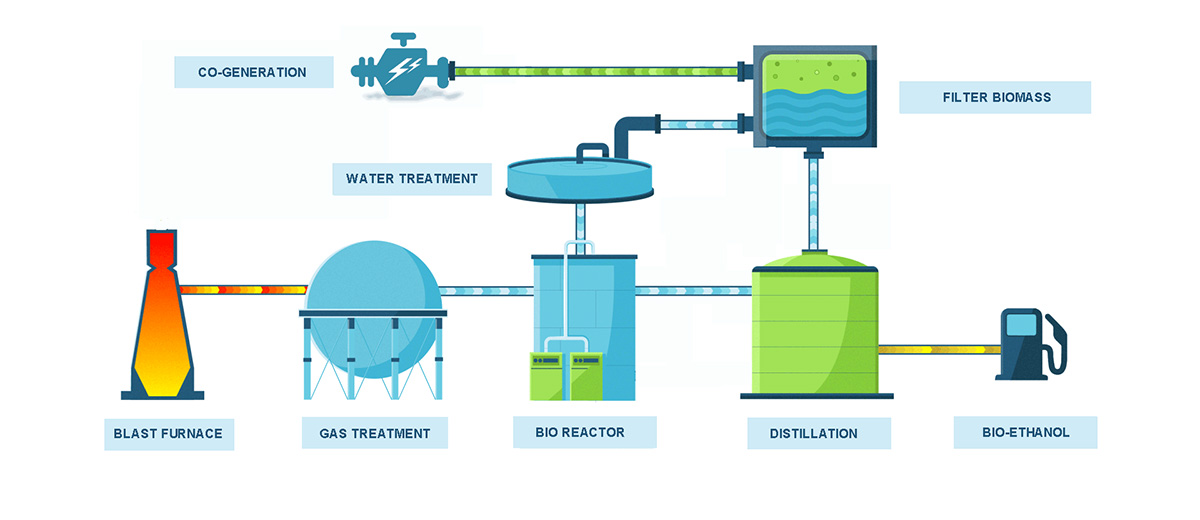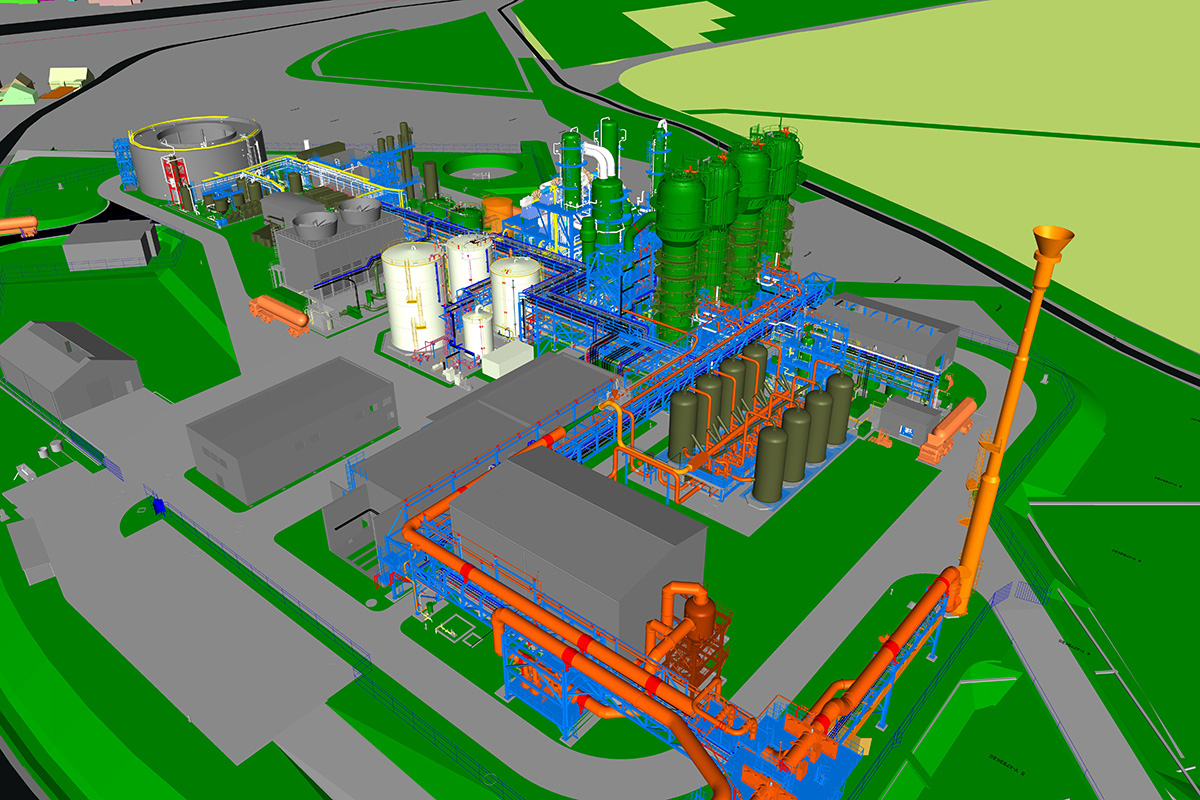Carl De Maré discusses how Carbalyst produce low carbon and renewable fuels through fermenting industrial process gasses from the iron and steel industry
In the steel industry, carbon is used primarily as a chemical reactant to reduce iron oxide to metallic iron. While alternative energy sources such as wind and solar can replace fossil fuels, they cannot replace carbon in steelmaking. Thus, the resulting steel-mill waste gases are unavoidable residues of industrial production. Off-gases generated with the blast furnace process or with one of the direct reduction processes contain significant amounts of carbon monoxide (CO), carbon dioxide (CO2), but lower amounts of hydrogen. In an integrated steel plant, these gases are used for thermal applications or for electrical power generation.
Carbalyst’s concept is a new approach to reduce CO2 emissions while producing low carbon liquid fuels and chemicals, which captures and recycles carbon-rich industrial off-gases to the global steel and ferro-alloy industry. The process uses naturally occurring microbes from the family of acetogens, or gas-fermenting organisms. These organisms represent one of the earliest life forms on Earth and utilise gases as the sole source of energy for their entire life cycle.
At its core the gas fermentation technology from technology partner LanzaTech uses carbon-containing waste and residue gases as both a nutrient and energy source for proprietary microorganisms rather than sugars as in traditional fermentation. The microbes in turn produce a diverse product suite including low carbon fuels and high-value chemicals used in everyday applications. Carbon-rich industrial gases such as off-gases produced during steel manufacture are transformed into commodity fuel and chemical products in a continuous process, providing a novel approach to carbon capture and reuse.
Instead of sending a residual gas stream to a thermal energy or electrical power generation unit, the gas, which is cooled and pretreated, is then injected into a fermentation vessel containing proprietary microbes and liquid media. The microbes convert the CO, CO2, and H2 into ethanol and chemicals that can be recovered from the fermentation broth. This is similar to the way that yeast makes ethanol from sugars except that the gases provide the sole source of carbon and energy for Carbalyst’s process.
The technology also has a significant impact on the carbon footprint of the produced products. Separate lifecycle analyses (LCAs) have shown that producing bioethanol from steel mill off-gas results in a product with lifecycle carbon emissions up to 87% lower than conventional gasoline depending on the carbon intensity of the local electrical grid. Where off-gases are used as a process input, an added benefit for the host steel mill is a reduction in CO2 emissions, as some carbon that would normally be combusted in heat and power production, or flared, is instead converted into a liquid product. Globally, up to 150 million tons of CO2 emissions could potentially be avoided by re-using available steel mill gas residues through the Carbalyst process. Gas fermentation also avoids combustion of the off-gas stream being converted, resulting in a substantial reduction in Particulate Matter (PM), SOx and NOx emissions up to 85% and higher. For ethanol alone, the market opportunity represented in the emissions of the steel industry is very significant. An analysis of large steel plants around the world reveals the potential to produce more than 40 billion litres of ethanol per year in China alone. Europe’s steel industry could produce almost twenty billion litres. The United States could see almost four billion.
In addition, the ethanol can be converted to jet fuel (2 litres of ethanol for 1 litre of jet fuel) to be used in aviation transport, where in the near future no sustainable alternative is available that is economically viable. Also, ethanol is the best candidate for a sustainable fuel in heavy fuel transport. Next to the transport sector the fermentation technology can be used to produce basic chemicals such as ethylene and propylene, which are used in the manufacture of everyday consumer goods. This represents a perfect example of the circular economy in which the carbon is recycled and locked into a new product, which can be further recycled, closing the loop from waste gas to chemical feedstock to consumer good that can be recycled further.
The project at ArcelorMittal will demonstrate the added value of recycling waste streams, not only by reducing emissions at the steel mill source, but by keeping fossil fuels in the ground through the production of commodity chemicals and fuels that would otherwise be made from oil. To produce the total amount 80 million litre ethanol, a small portion from the produced blast furnace off-gas will be utilised.
Approximately 50% of the carbon used in the chemistry of steelmaking leaves the process as carbon monoxide. Lanzatech’s technology, however, recycles these waste gases and ferments them with a proprietary microbe to produce bioethanol. Every ton of bioethanol produced, displaces 880 litres of gasoline as well as reducing CO2 emissions by 2.3 tons. The ethanol produced can also be further processed to produce sustainable aviation fuel via the alcohol to jet. Sustainable aviation fuel demand is poised to grow and Carbalyst could play a pivotal role in meeting this demand. Yet another outlet for sustainably produced ethanol is the chemical industry. The industry is under market pressure to produce lower carbon inputs for the various plants end products.
Governments around the world are setting ambitious targets for reduction of stationary carbon emissions from industrial installations such as the steel industry, thereby adding significant costs to steel production. Gas fermentation offers a new route to create value from iron and steelmaking off-gases while also meeting requirements to reduce greenhouse gas emissions. Additionally, the flexibility of gas fermentation will enable production of a wider range of chemicals over time, creating additional value for the iron and steel industry and deepening connections with the chemicals industry.
Acknowledgments
The Carbalyst project has received funding from the European Union’s Horizon 2020 research and innovation program under grant agreement No 656437.
Please note: This is a commercial profile













